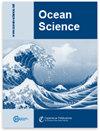地中海极端海洋夏季调查
IF 4.1
3区 地球科学
Q2 METEOROLOGY & ATMOSPHERIC SCIENCES
引用次数: 0
摘要
摘要地中海(Mediterranean Sea,MS)已经经历了显著的地表变暖,夏季尤为明显,并对海洋生物造成了破坏性影响。在对变暖趋势和海洋热浪(MHWs)进行持续研究的同时,我们在此探讨了解季节性异常变暖条件的重要性。我们提出了 "极端海洋夏季"(EMSs)的概念,并利用 1950-2020 年间的海表温度(SST)再分析数据研究了海洋夏季的特征。我们将特定地点的极端海洋夏季定义为夏季平均海温超过第 95 百分位数的夏季。在不同的 SST 子结构下,一个海洋夏季可能成为极端夏季。结果表明,在海盆的大部分地区,EMS 的形成主要是由于夏季较热的天数比正常天数要高。在海温分布的最热(最冷)部分变化较大的地区,出现 EMS 主要是由于海温分布的最热(最冷)部分异常温暖。在 EMS 内出现的 MHW 比平时强度更大、持续时间更长、频率更高,主要发生在 MS 北部地区。这些增强的 MHW 条件主要出现在海温分布的最暖部分。通过 MHW 条件的时间覆盖范围,可以发现 EMSs 中 MHW 的出现在盆地中部和东部更为明显,1950-2020 年期间,高达 55% 的 MHW 日发生在 EMSs 中。通过一种新提出的指标,对海气热通量在驱动 EMSs 中的作用进行了量化。结果表明,地表通量主要驱动了地中海北部的 EMSs,而海洋过程则在南部地区发挥了主要作用。上层海洋的先决条件也有助于 EMS 的形成。最后,制作了一个去趋势数据集,以研究海温的十年变化如何影响所研究的 EMS 特征。尽管这导致整个海盆的 EMS 变暖,但多年信号对 EMS 期间的主要 SST 子结构并无显著影响。研究结果还凸显了潜热通量在 EMS 期间调节地表热量收支方面的基本作用,与长期趋势无关。本文章由计算机程序翻译,如有差异,请以英文原文为准。
Investigating extreme marine summers in the Mediterranean Sea
Abstract. The Mediterranean Sea (MS) has undergone significant surface warming, particularly pronounced during summers and associated with devastating impacts on marine life. Alongside the ongoing research on warming trends and marine heatwaves (MHWs), here we address the importance of understanding anomalously warm conditions also on the seasonal timescale. We propose the concept of extreme marine summers (EMSs) and investigate their characteristics in the MS, using sea surface temperature (SST) reanalysis data spanning 1950–2020. We define EMSs at a particular location, as the summers with a mean summer SST exceeding the 95th percentile. A marine summer may become extreme, under various SST substructures. Results show that, in most of the basin, EMSs are formed primarily due to the warmer summer days being warmer than normal. Areas where the warmest (coldest) part of the SST distribution is more variable experience EMSs primarily due to the warmest (coldest) part of the distribution being anomalously warm. MHWs occurring within EMSs are more intense, longer lasting, and more frequent than usual mainly in the northern MS regions. These enhanced MHW conditions occur mainly within the warmest part of the SST distribution. By means of temporal coverage of MHW conditions, a more pronounced occurrence of MHWs in EMSs is found for the central and eastern basin where up to 55 % of MHW days over 1950–2020 fall within EMSs. The role of air–sea heat fluxes in driving EMSs is quantified through a newly proposed metric. Results suggest that surface fluxes primarily drive EMSs in the northern half of the MS, while oceanic processes play a major role in southern regions. Upper-ocean preconditioning also contributes to the formation of EMSs. Finally, a detrended dataset was produced to examine how the SST multi-decadal variability affects the studied EMS features. Despite leading to warmer EMSs basin-wide, the multi-decadal signal does not significantly affect the dominant SST substructures during EMSs. Results also highlight the fundamental role of latent heat flux in modulating the surface heat budget during EMSs, regardless of the long-term trends.
求助全文
通过发布文献求助,成功后即可免费获取论文全文。
去求助
来源期刊

Ocean Science
地学-海洋学
CiteScore
5.90
自引率
6.20%
发文量
78
审稿时长
6-12 weeks
期刊介绍:
Ocean Science (OS) is a not-for-profit international open-access scientific journal dedicated to the publication and discussion of research articles, short communications, and review papers on all aspects of ocean science: experimental, theoretical, and laboratory. The primary objective is to publish a very high-quality scientific journal with free Internet-based access for researchers and other interested people throughout the world.
Electronic submission of articles is used to keep publication costs to a minimum. The costs will be covered by a moderate per-page charge paid by the authors. The peer-review process also makes use of the Internet. It includes an 8-week online discussion period with the original submitted manuscript and all comments. If accepted, the final revised paper will be published online.
Ocean Science covers the following fields: ocean physics (i.e. ocean structure, circulation, tides, and internal waves); ocean chemistry; biological oceanography; air–sea interactions; ocean models – physical, chemical, biological, and biochemical; coastal and shelf edge processes; paleooceanography.
 求助内容:
求助内容: 应助结果提醒方式:
应助结果提醒方式:


